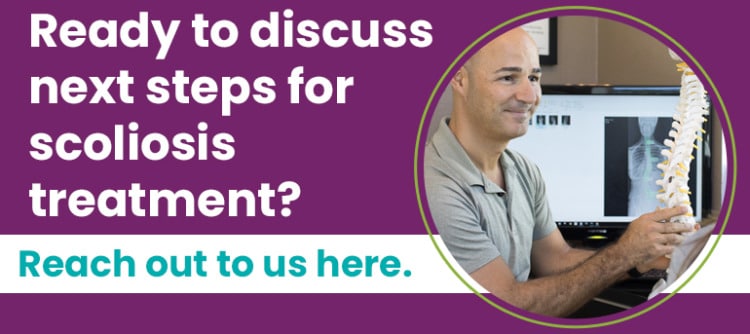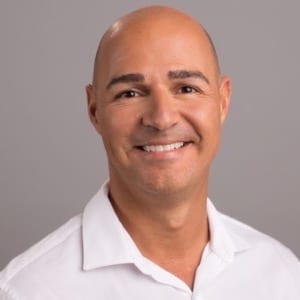Physical Therapy for Scoliosis: Spine Relief Solutions
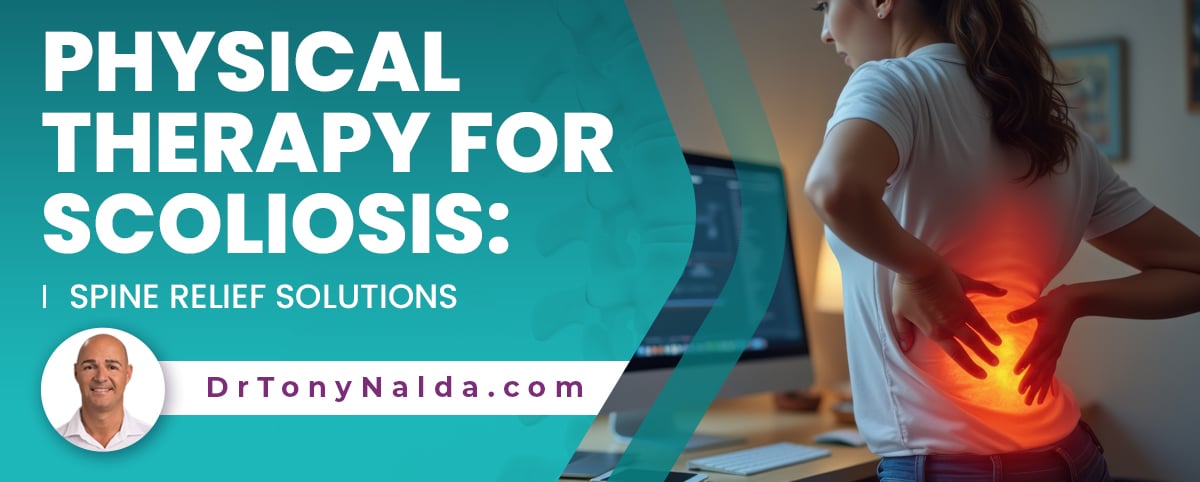
A spine that's strong and flexible is going to be more responsive to treatment. Scoliosis-specific physical therapy can help make the spine more responsive and correct the scoliosis. Although a progressive condition, scoliosis can be highly treatable, and physical therapy is at the center of a nonsurgical treatment approach.
A healthy spine is key to quality of life as it facilitates pain-free movement and a wide range of motion. Physical therapy for scoliosis can help manage pain, increase spinal flexibility, reduce curve size, and improve the spine's surrounding muscle balance and strength.
Let's talk briefly about the difference between general physical therapy and scoliosis-specific physical therapy.
Table of Contents
Physical Therapy
Physical therapy focuses on helping the body function optimally; it relies on a number of disciplines including exercise, manual therapy, and a number of therapies that rely on physical stimuli to improve mobility, function, and provide pain relief (massage, hot/cold therapy).
Physical therapy can work towards a number of goals, so a patient's initial evaluation includes discussing a patient's treatment goals and how to work backwards with a customized treatment plan.
A physical therapist will assess how a patient moves, how flexible and strong they are in different parts of the body, and can customize a treatment plan accordingly.
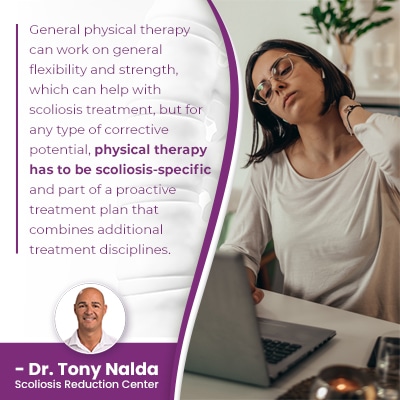 General physical therapy can work on general flexibility and strength, which can help with scoliosis treatment, but for any type of corrective potential, physical therapy has to be scoliosis-specific and part of a proactive treatment plan that combines additional treatment disciplines.
General physical therapy can work on general flexibility and strength, which can help with scoliosis treatment, but for any type of corrective potential, physical therapy has to be scoliosis-specific and part of a proactive treatment plan that combines additional treatment disciplines.
Scoliosis-Specific Physical Therapy
Scoliosis is a highly-prevalent spinal condition that causes an unnatural sideways-bending and rotating spinal curve to develop, and as a progressive condition, its nature is to get worse over time.
We don't know what causes the initial onset of scoliosis in most cases, but we know it's growth that makes it progress.
Scoliosis ranges widely in severity from mild scoliosis to moderate scoliosis, severe, and very severe cases, and there are also different types determined by causation.
Most cases of scoliosis (approximately 80 percent) are idiopathic, meaning cause unknown, and the remaining 20 percent are less common and are associated with known causes: neuromuscular scoliosis, degenerative scoliosis, and congenital scoliosis.
Scoliosis can also develop in any spinal section, or in more than one as an S-shaped curve, so as you can see, a generic treatment plan will fall short when it comes to addressing the specifics of a patient's scoliosis; the complex nature of scoliosis necessitates the complete customization of effective treatment plans, so a scoliosis-specific physical therapist is needed.
A scoliosis physical therapist understands the spine and how scoliosis affects it, and they know how to impact the condition with treatment for long-term corrective results.
So what does physical therapy do for scoliosis patients?
Physical Therapy and Spinal Flexibility
A challenge to treating scoliosis is its progressive nature. As scoliosis progresses, the size and rotation of the unnatural spinal curve is increasing, as are the condition's effects, one of which is spinal rigidity.
The spine gets increasingly rigid alongside progression, and this makes it less responsive to treatment, hence the benefit of starting treatment early before a lot of progression has already occurred.
Nonsurgical treatment is chiropractic-centered, and spinal flexibility is a key factor in how responsive the spine is, how easily its position can be improved, and stability increased.
Physical therapy uses scoliosis-specific exercise to improve the spine's flexibility, making it more responsive to manual adjustments that works towards improving the curve's most-tilted vertebrae: restoring their alignment with the rest of the spine.
A spine that's flexible is also one that can perform additional therapeutic exercises that are key to treatment.
In patients who have already progressed significantly prior to being diagnosed, some physical therapy may be necessary to restore a baseline level of spinal flexibility before starting treatment.
Muscle Balance and Strengthening Exercises
A spine needs help from its surrounding muscles to maintain its health curves and alignment. A key facet of nonsurgical scoliosis treatment is physical therapy that works towards improving core strength.
A spine that's surrounded by strong muscles is one that has support and stability, and as scoliosis is associated with muscular imbalance, in addition to muscle strengthening, improving the spine's surrounding muscles balance is also a focus.
As an unnatural spinal curve can pull its surrounding muscles in different directions, muscles on one side of the spine can become stretched and sore from overuse, while muscles on the other side can become weak from lack of use; a scoliosis-specific exercise program can improve muscle balance and strength.
A spine that's surrounded by balanced muscles is one that's more stable and balanced; a misaligned spine can disrupt the balance and stability of the entire body.
Pain Relief
Pain relief is also a focus of scoliosis treatment, but more so in adults than in childhood scoliosis treatment.
Scoliosis becomes compressive once growth has stopped, and compression is the main cause of condition-related pain.
Compression is uneven pressure, and can affect the spine and its surrounding muscles and nerves. Scoliosis pain can range from mild and intermittent to chronic pain that's debilitating and disrupts quality of life.
Pain management is more necessary for adults, and physical therapy and scoliosis-specific exercise is key to counteracting increasing spinal rigidity and taking pressure off the spine.
A spine that's more flexible can mean a body with a better range of motion and healthier movement patterns.
Scoliosis disrupts the body's posture and movement, so physical therapy can help preserve healthy movement patterns that can reduce uneven wear and tear on the spine, preserving its natural function and mobility.
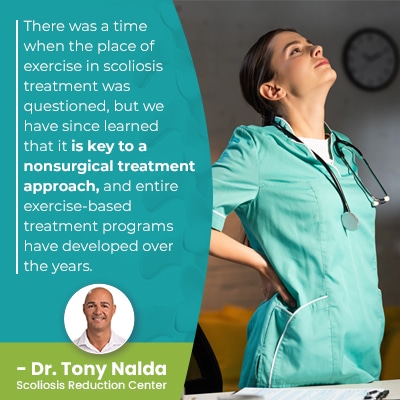 There was a time when the place of exercise in scoliosis treatment was questioned, but we have since learned that it is key to a nonsurgical treatment approach, and entire exercise-based treatment programs have developed over the years.
There was a time when the place of exercise in scoliosis treatment was questioned, but we have since learned that it is key to a nonsurgical treatment approach, and entire exercise-based treatment programs have developed over the years.
The Schroth Method and SEAS
Physical therapy treatment also has the focus of improving a patient's posture as this is necessary for sustaining long-term treatment results.
Poor posture can introduce adverse spinal tension, and over time, it can contribute to spinal degeneration and increase curve progression.
The Schroth method is the most commonly used scoliosis-specific physical therapy program for scoliosis treatment, and it is customized to address the specifics of a patient's curve and body type, including posture and experienced symptoms.
Posture and Breathing
Through the use of mirror image exercises, patients are taught how to hold their bodies to best impact their curve size and support treatment efforts, and postural awareness is always a focus of nonsurgical scoliosis treatment.
The method also includes teaching patients rotational angular breathing to help de-rotate the spine and improve lung function.
Healthy posture is key to leading a spine- and scoliosis-friendly lifestyle and sustaining long-term treatment results.
SEAS (Scientific Exercise Approach to Scoliosis) is also a physical therapy program for scoliosis treatment that uses the power of targeted exercises to achieve postural remodeling and neuromotor function.
Posture isn't just about body positioning; it also involves how the brain communicates with the body, so physical therapy can work towards improving posture, mobility, reducing pain, inflammation, curve size, managing progression, strengthening and balancing the spine's surrounding muscles, and improving brain-body communication.
Conclusion
Treatment options for scoliosis include surgery or conservative treatment that includes scoliosis-specific physical therapy.
Here at the Scoliosis Reduction Center®, conservative treatment plans are customized and proactive; the goal of treatment is to prevent progression, increasing condition effects, and the need for invasive surgical treatment.
Rehabilitation specialists can help patients recovering from scoliosis by teaching patients a number of targeted exercises that are customized to address the specifics of a patient's curve type, body type, symptoms, and treatment goals.
Treatment plans for scoliosis need to be customized because no two cases are the same, and as conservative treatment involves combining the power of multiple scoliosis-specific treatment disciplines, plans can be adjusted accordingly based on how a patient's spine is responding to treatment and/or growth.
Physical therapy for scoliosis works towards improving a patient's posture, spinal flexibility, pain, strength, muscle balance, stability, and brain-body communication.
When combined with other proactive treatments such as scoliosis-specific chiropractic care and corrective bracing, physical therapy can help reduce pain and manage progression, and when it is evidence-based and corrective, it can also help reduce the curve size or corrective results.
Dr. Tony Nalda
DOCTOR OF CHIROPRACTIC
After receiving an undergraduate degree in psychology and his Doctorate of Chiropractic from Life University, Dr. Nalda settled in Celebration, Florida and proceeded to build one of Central Florida’s most successful chiropractic clinics.
His experience with patients suffering from scoliosis, and the confusion and frustration they faced, led him to seek a specialty in scoliosis care. In 2006 he completed his Intensive Care Certification from CLEAR Institute, a leading scoliosis educational and certification center.
About Dr. Tony Nalda
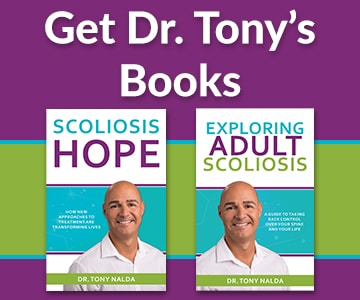 Ready to explore scoliosis treatment? Contact Us Now
Ready to explore scoliosis treatment? Contact Us Now